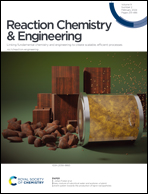Energetics of acid catalyzed biomass reactions: how and why does the solvent model matter?†
Abstract
Condensed phase selective transformation of biomass to platform chemicals is susceptible to the solvent environment. Selectivities and conversions in several key acid-catalyzed biomass reactions change significantly with the addition of a co-solvent to the reacting system. Hence, when molecular modeling tools are implemented to investigate these reactions, it is imperative to select a solvent model that can compute reaction energetics accurately and can capture and explain the “role” of solvent in altering them. Hence in this paper, we systematically compare popularly used implicit and explicit solvation approaches to model the protonation reaction of a biomass derived moiety, with and without reaction and solvent dynamics, using water and DMSO as co-solvents. This systematic comparison reveals that unlike routinely performed DFT calculations in implicit solvents, where the free energy profiles do not change significantly due to changes in solvent composition, the reaction free energy using explicit equilibrated solvation without solvent and reaction dynamics was found to be ∼67 kJ mol−1 higher at 75 wt% DMSO compared to lower DMSO proportions. However, the effect of solvent environment on free energy barriers was only captured when solvent and reaction dynamics were considered. The increase in activation-free energy with the addition of the co-solvent is due to changes in the solvent reorganization energy and non-equilibrium solvation.



 Please wait while we load your content...
Please wait while we load your content...